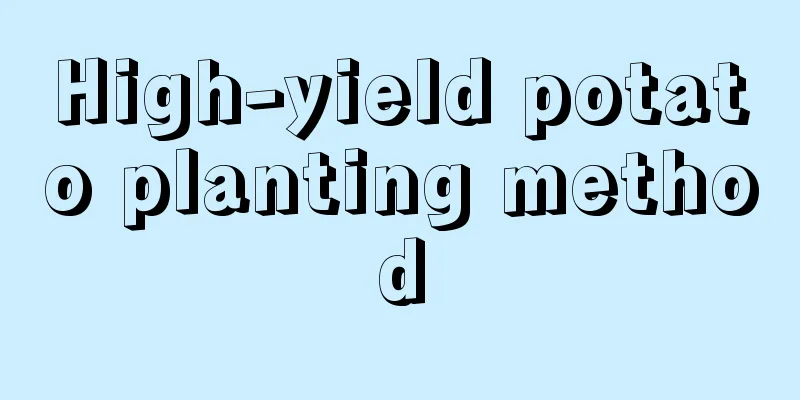High-yield potato planting method

|
Open-field cultivation is the most common method of growing potatoes, but open-field cultivation of potatoes is greatly affected by natural climate, which often leads to unstable growth cycles and affected yields. So what are some high-yield methods for growing potatoes? Let’s learn more about it below. 1. Greenhouse cultivation By controlling environmental conditions such as temperature, humidity, light, etc. in greenhouses, a stable environment is provided for potato growth to achieve high yields and extend the market supply period. The main material for building the shed is small bamboo, and the specifications of the shed are: bottom width 4.3-4.5m, arc height 6.3m, and shed height 1.7-1.8m. The greenhouse is divided into double beds, each bed is 2m wide, the middle ditch is 35cm, and the operating ditch between greenhouses is 70cm. The length of the shed depends on the field, and 30-45 sheds can be built in about 100 square meters. When reusing an old shed, it is necessary to disinfect it with quicklime and new lipid film before sowing. 2. Soilless cultivation Using nutrient solution instead of soil to grow potatoes can save water, reduce the occurrence of diseases, and increase yield and quality. Generally speaking, the pH value of the nutrient solution for soilless potato cultivation is more suitable at 5.8-6.0. When cultivating in solid substrate, the pH of the substrate must be maintained at 5.5-7.0. In order to maintain sufficient nutrients in the water, you can change the water and supplement nutrients once a week or so. 3. Vertical Planting Use three-dimensional planting techniques, such as wooden box towers or cylindrical fences, to make full use of vertical space and increase yield per unit area. When planting, you can use specially made vertical planting bags, planting towers, planting columns or planting walls. And be careful to provide adequate nutrients, either by regularly adding liquid fertilizer or using pre-made fertilizer blocks. 4. Hydroponic planting Hydroponics is a method of cultivation that does not use soil. It provides the nutrients needed by plants through a circulating water system and is suitable for the cultivation of crops such as potatoes. Hydroponics does not mean burying potatoes in water, but using a relatively large pot but lower than a vase, and planting them with the water level at one-third of the height of the potatoes. The water quality should be clean rainwater, snow water, purified water, tap water with evaporated chlorine, etc. The water needs to be changed every few days to ensure good water quality. 5. Intercropping Intercropping with other crops such as corn can improve land utilization, increase yield and profits. Potato seeds need to be germinated and cut into pieces when the sprouts are 1-1.5 cm long, with 30-40 pieces per kilogram. Use the space after corn seedlings emerge for intercropping. You can intercrop two rows of potatoes with three rows of corn, with a row spacing of 50-60 cm and a plant spacing of 20 cm. These are some |
<<: How can we get high yield from growing potatoes?
>>: What fertilizer can be used to grow potatoes for high yield?
Recommend
Why do the leaves of the green radish wilt after repotting? What should I do?
1. Proper watering The leaves of the green radish...
Prevention and control of peony diseases and pests, does peony need to be dewormed?
1. Diseases 1. Gray mold: This disease mainly har...
The cultivation methods and precautions of Platinum kudzu
Platinum Pothos is very easy to grow and has a hi...
Can succulents be grown with wood ash?
Can wood ash be used to grow succulents? Wood ash...
Cantaloupe planting time and method
Cantaloupe planting time There are usually two so...
Polygonum cuspidatum planting, yield per mu, profit, planting technology and economic benefits of Polygonum cuspidatum
The rhizome of Polygonum cuspidatum is very stron...
How to prune boxwood bonsai
Boxwood bonsai pruning Boxwood bonsai are usually...
How to prune Longyou plum
How to prune the branches of Longyou plum Under n...
How to cultivate wild peony
1. Soil When breeding, use loose, fertile and sli...
Can leftover Coke be used to water flowers? What flowers can be watered?
Can leftover Coke be used to water flowers? Gener...
I used to think that “fruits” were not too expensive, but after seeing these 10 kinds, I was really slapped in the face!
10. Pineappleberry Pineapple berry is a fruit tha...
Planting method and time of open-air autumn cucumbers: when is the best time to plant them?
Suitable time for planting open-air autumn cucumb...
What soil is used to grow desert roses?
1. Soil The soil for growing desert roses should ...
How to Plant Sunflower Seeds
Tools/Raw Materials Sunflower seeds Flower pot co...
What are the cultivation methods and precautions of glass jade?
Glass Jade Introduction Glass Jade is a plant of ...









